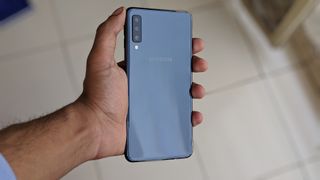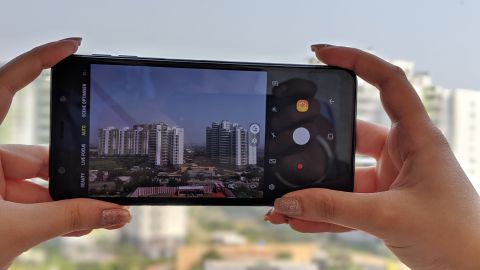TechRadar Verdict
Samsung continues to experiment with the Galaxy A7. It's a well-balanced smartphone with a camera you can get creative with. Additionally, it gets a new svelte flat-glass design, brilliant display and an impressive battery backup. At its asking price, the Galaxy A7 is a highly-competitive device that can only be challenged when it comes to sheer performance.
Pros
- +
Stunning display
- +
Flush design
- +
Impressive daylight camera performance
Cons
- -
No USB Type-C
- -
Not suited for intensive gaming
Why you can trust TechRadar
The Samsung Galaxy A7 is a phone that you might notice because of its looks, explore because of its display and buy because of its camera. That's the kind of balance that Samsung has tried to strike with their first triple camera phone.
From what we saw on paper, the Galaxy A7 (2018) looked like a phone that's made for everyone. And by everyone, we mean that it packs a decent set of hardware in a premium looking shell and a camera you can get creative with.
At its price, the 4GB RAM variant of the Galaxy A7 competes against the likes of the POCO F1, Honor Play, Nokia 7 Plus and Vivo V11 Pro. Among all the competing handsets, there's hardly any option that serves different consumer demands without any compromise. For instance, the POCO F1 offers raw power, but the Vivo V11 Pro shines in the design and display department. Whereas, the Nokia 7 Plus offers the best software experience among all.
We took the Galaxy A7 out for a spin to find out if it is THE mid-range smartphone that can suffice all.

Key features
- Three rear cameras
- 6-inch FHD Super AMOLED display
- Looks like a flagship, performs like a mid ranger
The Samsung Galaxy A7 (2018) is the first Samsung phone to boast of a triple camera setup, and the second one in India after the Huawei P20 Pro. Of the three cameras, the primary is a 24-megapixel sensor with a f/1.7 aperture, the secondary is an 8MP sensor and ultra-wide lens with a f/2.4 aperture, and finally, there's a 5MP depth sensor with a fixed-focus lens and f/2.2 aperture. The highlight here is the 8MP sensor as it has a 13mm 'ultra-wide' lens with a 120-degree field of view.
It also has a big 6-inch Super AMOLED full HD (1080p) display, that's best in the league for multimedia consumption. The company also emphasizes on the Widevine L1 certification, which enables users to stream content in HD.
Design
- Metal and glass design
- micro USB charging
- Flat surface
From the very first look, it's easy to guess that the Galaxy A7 is a Samsung phone. The quality of material and the precision of finish is seen on flagship phones like the Galaxy Note 9. Similar to its predecessor, the Galaxy A7 (2018) comes in a glass and metal sandwich design, but without any curves on the sides. It gets a rich-looking reflective glass surface on the rear, that shifts shades in different light.
Since it's back is all glass, it's a given that it's a fingerprint magnet and prone to cracking when dropped with an impact. But I have an instance to share. It was my first day with the Galaxy A7 and I accidentally slipped it on a marble flooring from a height of about three feet. The sound gave me instant chills, but to my surprise, it survived. While that doesn't qualify it to be called as a shatterproof phone, but I would still call it a sturdy and well-built handset.
A sturdy body-colored aluminum rim surrounds the body. It has rounded corners and curves to give it a pleasant in hand feel. Although, its big size makes it difficult to operate with one hand.
There's a welcome change in the design this time. After experimenting with the fingerprint sensor on their phones, Samsung finally put fingerprint into the power/lock key like Sony Xperia handsets. You don't have to make an extra effort to reach, as it falls right under the thumb while holding it with the right hand. The power button is still clickable, but you don’t need to press it to unlock the phone.
The triple camera placement is very subtle. The setup resides on the top left corner with a LED flash below it. We must say that Samsung does a great job at keeping the handsets void of any unusual camera protrusion. Even on the Galaxy A7, there's a very tiny bump despite the three cameras.

On the front, the Galaxy A7 looks like its other cousins. There's no sign of a notch on top, instead, there's a thick chin and a forehead where it resides the earpiece, front camera and an LED flash. So, don't expect a notch or even a nearly bezeless design. It looks more like the Pixel 2 XL from last year from the front.
The volume is placed above the power key/fingerprint sensor on the right side. The SIM and microSD card slot is on the left and the 3.5mm audio jack, loudspeaker and a micro USB port are at the bottom. In all honesty, a micro USB is one of the biggest letdowns on the Galaxy A7. Especially, when OEMs like Nokia are putting a Type-C on phones priced below Rs 15,000.

Display
- 6-inch 18.5:9 LCD screen, 1080 x 2220 pixels
- No notch
The Samsung Galaxy A7 (2018) has a tall 6-inch 18.5:9 Super AMOLED panel with full HD (1080x2220p) resolution.
Like most Samsung displays, this one is punchy and vivid straight out of the box. AMOLED panels are naturally crisp and reproduce vivid color tones, and the same is the case on the Galaxy A7. It is sharper than almost every other phone in its league and can be rated as the finest display among the competition.
The sheer size of the display makes the Galaxy A7 makes it a well-suited phone for gaming, video streaming and scrolling social media content.
Brightness levels are high, making it clearly visible under bright and sunny outdoors. It can also be viewed from extreme angles without any obstruction.
Sudhanshu Singh have been working in tech journalism as a reporter, writer, editor, and reviewer for over 5 years. He has reviewed hundreds of products ranging across categories and have also written opinions, guides, feature articles, news, and analysis. Ditching the norm of armchair journalism in tech media, Sudhanshu dug deep into how emerging products and services affect actual users, and what marks they leave on our cultural landscape.
His areas of expertise along with writing and editing include content strategy, daily operations, product and team management.


